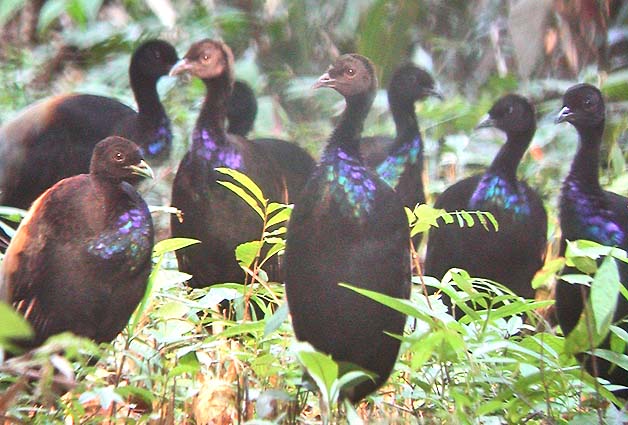
|
a web page by Don
Roberson
|
|
TRUMPETERS
Psophiidae
|
|
|
|
 Trumpeters are secretive, gregarious,
ground-dwelling birds of humid lowland forests in northern South
America. For most visitors they are elusive ghosts that melt into the
jungle, so a well-lit photo like this (left) — Gray-winged
Trumpeter in Venezuela — is a real coup (© David
Fisher). So far my own experiences have been but brief glimpses of
odd-looking birds running away across the forest floor. Trumpeters are secretive, gregarious,
ground-dwelling birds of humid lowland forests in northern South
America. For most visitors they are elusive ghosts that melt into the
jungle, so a well-lit photo like this (left) — Gray-winged
Trumpeter in Venezuela — is a real coup (© David
Fisher). So far my own experiences have been but brief glimpses of
odd-looking birds running away across the forest floor. |
|
|
Trumpeters are about the size of a domestic chicken but are unrelated to the gallinaceous families. They are in the Gruiformes, and possibly most closely related to such relict groups as the seriemas, Kagu, and Limpkin (Sherman 1996). Both the molecular and paleontological evidence (Cracraft 1982, Sibley & Ahlquist 199) suggests that they arose 60-70 million years ago, and some of their close relatives (e.g., family Phororhacidae) have since become extinct. Today there is just a single genus of Trumpeters in northern South America (Psophia) with three extant species: Gray-winged, Pale-winged P. leucoptera, and Dark-winged P. viridis. These are distinguished primarily by the color of the upper wing coverts; the three species exist in differing parts of the Amazon and Orinoco Basins. |
|
|
|
|
Trumpeters are resident species that live year-round in small parties of 3-13 individuals. The few studies to date suggest that the typical group is 7 birds, which usually includes three unrelated adult males, two unrelated adult females, and their immature offspring. The groups are cohesive and social but have complex within-sex hierarchies (Sherman 1996). All are primarily frugivorous, foraging on the forest floor for fallen fruit or taking them off understory bushes, but they will also eat small vertebrates and some invertebrates (10% of their diet in some studies). Although Trumpeters are named for their voice — and they can be quite vocal — the call is not very trumpet-like. Sherman (1996) describes it as a loud "quick descending series of 3-5 staccato notes followed by a long, low-pitched, descending and resonant vibrato Oh-oh-oh-oh-ooooooooooh." None of the three species is currently considered endangered, but all species are declining, imperiled by hunter and deforestation. My own personal hope is that my next encounter will be much more prolonged, and that I might have David Fisher's luck with photography! |
|
|
Photos: David Fisher photographed the party of Gray-winged Trumpeter Psophia crepitans at Junglaven, Venezuela, in March 2007. Photo © 2007 David Fisher, used with permission; all rights reserved. Bibliographic note: There is no "family book" per se, but a fine introduction to this family, with some fine photos, is in Sherman (1996). Literature cited:
|